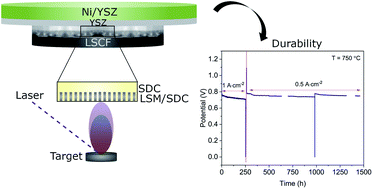Functional thin films as cathode/electrolyte interlayers: a strategy to enhance the performance and durability of solid oxide fuel cells†
Abstract
Electrochemical devices such as solid oxide fuel cells (SOFC) may greatly benefit from the implementation of nanoengineered thin-film multifunctional layers providing, alongside enhanced electrochemical activity, improved mechanical and long-term stability. In this study, an ultrathin (400 nm) bilayer of samarium-doped ceria and a self-assembled nanocomposite made of Sm0.2Ce0.8O1.9-La0.8Sr0.2MnO3-δ was fabricated by pulsed laser deposition and is employed as a functional oxygen electrode in an anode-supported solid oxide fuel cell. Introducing the functional bilayer in the cell's architecture results in a simple processing technique for the fabrication of high-performance fuel cells (power density 1.0 W cm−2 at 0.7 V and 750 °C). Durability tests were carried out for up to 1500 h, showing a small degradation under extreme operating conditions of 1 A cm−2, while a stable behaviour at 0.5 A cm−2 (2.8% Vin kh−1). Post-test analyses, including scanning and transmission electron microscopy and electrochemical impedance spectroscopy, demonstrate that the nanoengineered thin film layers remain mostly morphologically stable after the operation.



 Please wait while we load your content...
Please wait while we load your content...